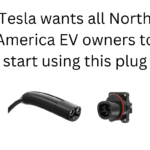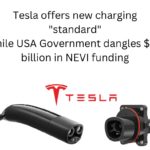Tesla Motors has chosen the Tahoe-Reno Industrial Center to house the Gigafactory. While we’re excited at the fact that Tesla has made a bold concrete step forward with their plans, reiterating the goal of selling 500,000 electric cars a year by 2020, there’s a big question – the incentives package. We understand that Big Business in America often involves talking Governments into “investing” money in the Business activities – translated, that means giving the business a subsidy in terms of tax credits or tax abatements so the business will go ahead and do something the business should be doing anyway.
Tesla Motors needs to build this Gigafactory anyway, so why not just get on with the business of doing so? Why play this big game getting various state governments to compete with each other to come up with the best incentives package?
Don’t look at me like I’m being naive. This is an honest question – why should our tax dollars be spent this way to subsidize businesses?
Before the deal was announced it was estimated Nevada was going to subsidize Tesla by about 10% of the factory’s cost – or $400 million.
The Albuquerque Business Journal posted an interview with Albuquerque Economic Development’s Gary Tonjes![]() about the negotiations. He said Nevada had offered $1.3 billion, which he thought wasn’t surprising for a project this size. Tonjes described some new tax laws passed last year in New Mexico as having taken away “one of the biggest obstacles the state had to job creating” and playing a critical role in New Mexico being a finalist in the competition.
about the negotiations. He said Nevada had offered $1.3 billion, which he thought wasn’t surprising for a project this size. Tonjes described some new tax laws passed last year in New Mexico as having taken away “one of the biggest obstacles the state had to job creating” and playing a critical role in New Mexico being a finalist in the competition.
During a Gubernatorial election campaign debate last night![]() , California Gov. Brown said that Tesla Motors wanted a huge up-front cash payment.
, California Gov. Brown said that Tesla Motors wanted a huge up-front cash payment.
- $725 million for a 20-year 100 percent sales tax abatement
- $332 million for a 10-year 100 percent property tax abatement
- $120 million in transferable tax credits
- $75 million in transferable tax credits worth $12,500 per job times 6,000 jobs).
- $27 million for a 10-year, 100 percent modified business tax abatement
- $8 million in discounted electricity rates for eight years
Project Highlights
- Approximately $100,000,000,000 in economic impact over 20 years
- 6,500 direct jobs on-site with an average wage in excess of $25 per hour and full benefit package
- Facility will be one of the largest buildings in the world
- 5 million+ square foot battery manufacturing facility, “Gigafactory”
- $5 billion initial investment in facility within 3-5 years: ($1 billion in building, $4 billion in equipment)
- An additional $5 billion in planned replacement equipment over a subsequent 10 year period, or a total investment of $10 billion
- Peak construction employment of more than 3,000 construction and installation workers over a three year period
- Expansion of USA Parkway to connect Highway 50 to Interstate 80
- Tesla will make a direct contribution to K-12 education of $37.5 million beginning in August 2018
- Tesla will commit to grant $1 million to fund advanced battery research at UNLV
- Tesla will prioritize the employment of Nevadans and Veterans
Economic Data
- Gigafactory will create 16,000 indirect jobs in the community
- Total of over 22,000 jobs
- Gigafactory will increase state employment by approximately 2%, and regional employment by more than 10%
- Direct economic impact generated by the project will be nearly $40 billion over 20 years
- Indirect economic impact will be approximately $60 billion over 20 years
- The Gigafactory will add over 3% to the State’s Gross Domestic Product which represents more than a 20% increase in regional GDP
- Estimated value of abatements is between $675 million and $1.1 billion depending upon size of investment
Fiscal Projections After Abatements
- $430 million in state General Fund revenue over 20 years
- $950 million in local government revenue over 20 years
- $500 million in K-12 education revenue over 20 years
- $1.9 billion in total fiscal impact
ABATEMENTS
- Up to 100% abatement of Sales Tax until June 30, 2034
- Up to 100% abatement of Real Property Tax until June 30, 2024
- Up to 100% abatement of Personal Property Tax until June 30, 2024
- Up to 100% abatement of Modified Business Tax until June 30, 2024
TAX CREDITS*
- Transferable Tax Credit of $12,500 per permanent, full-time job, up to 6,000 jobs – average wage of jobs must be $22 per hour to qualify
- Transferable Tax Credit of 5% of first $1 billion investment
- Transferable Tax Credit of 2.8% of next $2.5 billion investment
ECONOMIC DEVELOPMENT RATE RIDER
- Extension of Economic Development Rate Rider electric program from 5 to 10 years
DIRECT SALES
- Clarify that manufacturers that exclusively produce electric passenger vehicles and have not engaged in a franchise with a dealer in the State may engage in retail sales of those vehicles
*Repurposing of Existing Tax Credits
- Reduce Film Tax Credit program from $80 million to $10 million
- Sunset the Home Office Tax Credit program at a value of $125 million over the first five years
- Highway design could decrease death and injury risk, if “we” chose smarter designs - March 28, 2015
- GM really did trademark “range anxiety”, only later to abandon that mark - March 25, 2015
- US Government releases new regulations on hydraulic fracturing, that some call “toothless” - March 20, 2015
- Tesla Motors magic pill to solve range anxiety doesn’t quite instill range confidence - March 19, 2015
- Update on Galena IL oil train – 21 cars involved, which were the supposedly safer CP1232 design - March 7, 2015
- Another oil bomb train – why are they shipping crude oil by train? – Symptoms of fossil fuel addiction - March 6, 2015
- Chevron relinquishes fracking in Romania, as part of broader pull-out from Eastern European fracking operations - February 22, 2015
- Answer anti- electric car articles with truth and pride – truth outshines all distortions - February 19, 2015
- Apple taking big risk on developing a car? Please, Apple, don’t go there! - February 16, 2015
- Toyota, Nissan, Honda working on Japanese fuel cell infrastructure for Japanese government - February 12, 2015



















Pingback: | The Long Tail Pipe